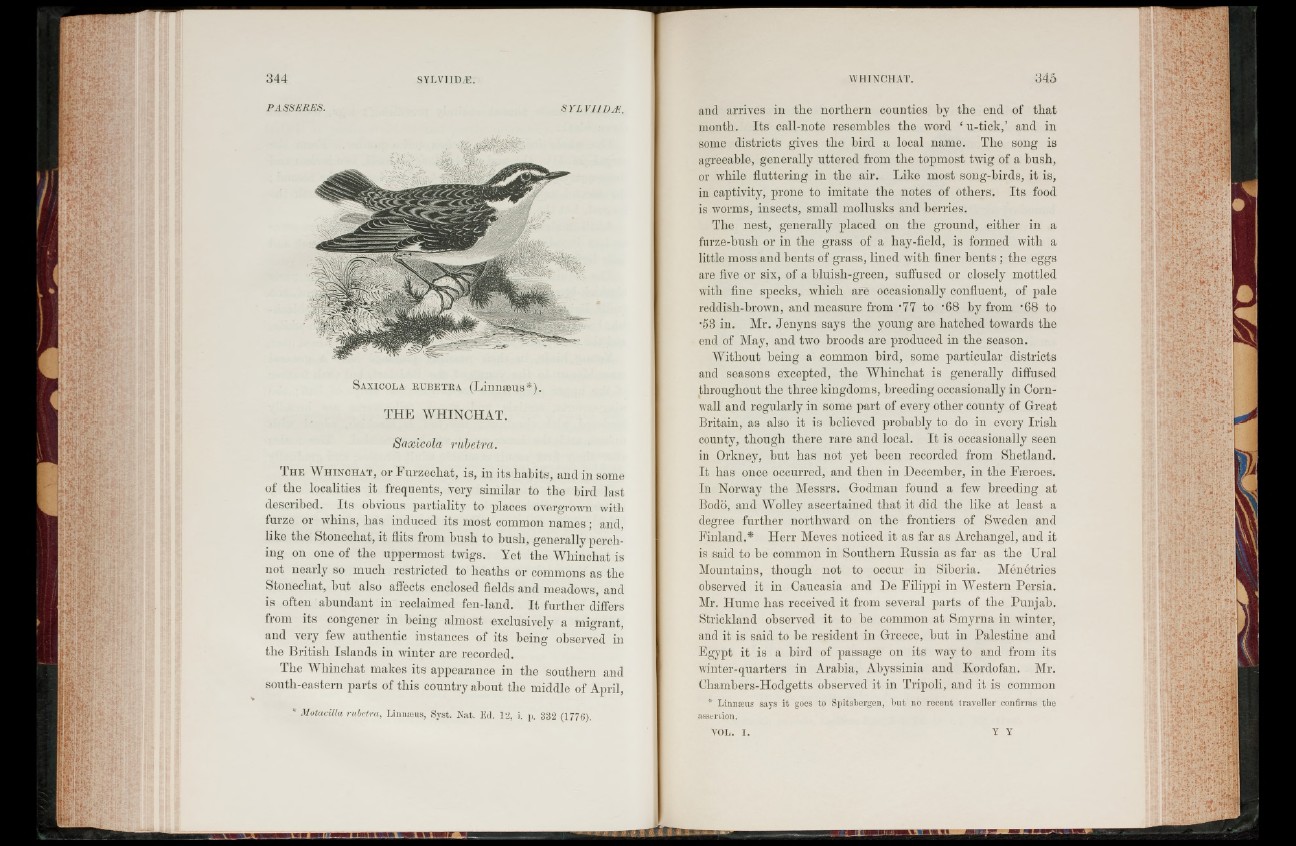
A t
Vtr,
h ¡r* :
,aV
• •••vV
gjfK
I f f l
I I
í f l n ¿
>«■
i'U %
.*v •,.
* $ ?«
rfe *T
PA SSJMES. SY LV11 DJi.
S axícola r u b e t r a (Linnaeus*).
THE WHINCHAT.
Saxícola rubetra.
T h e W h in c h a t , or Furzechat, is, in its habits, and in some
of the localities it frequents, very similar to the bird last
described. Its obvious partiality to places overgrown with
furze or whins, has induced its most common names; and,
like the Stonechat, it flits from bush to bush, generally perching
on one of the uppermost twigs. Yet the Whinchat is
not nearly so much restricted to heaths or commons as the
Stonechat, but also affects enclosed fields and meadows, and
is often abundant in reclaimed fen-land. I t further differs
from its congener in being almost exclusively a migrant,
and \e iy few authentic instances of its being observed in
the British Islands in winter are recorded.
The Whinchat makes its appearance in the southern and
south-eastern parts of this country about the middle of April,
4 Motacilla rubetra, Linnaeus, Syst. Nat. Ed. 12, i. p. 332 (1776).
and arrives in the northern counties by the end of that
month. Its call-note resembles the word * u-tick,’ and in
some districts gives the bird a local name. The song is
agreeable, generally uttered from the topmost twig of a bush,
or while fluttering in the air. Like most song-birds, it is,
in captivity, prone to imitate the notes of others. Its food
is worms, insects, small mollusks and berries.
The nest, generally placed on the ground, either in a
furze-bush or in the grass of a liay-field, is formed with a
little moss and bents of grass, lined with finer bents ; the eggs
are five or six, of a bluish-green, suffused or closely mottled
with fine specks, which are occasionally confluent, of pale
reddish-brown, and measure from *77 to ‘68 by from -68 to
•53 in. Mr. Jenyns says the young are hatched towards the
end of May, and two broods are produced in the season.
Without being a common bird, some particular districts
and seasons excepted, the Whinchat is generally diffused
throughout the three kingdoms, breeding occasionally in Cornwall
and regularly in some part of every other county of Great
Britain, as also it is believed probably to do in every Irish
county, though there rare and local. I t is occasionally seen
in Orkney, but has not yet been recorded from Shetland.
It has once occurred, and then in December, in the Faeroes.
In Norway the Messrs. Godman found a few breeding at
Bodo, and Wolley ascertained that it did the like at least a
degree further northward on the frontiers of Sweden and
Finland.* Herr Meves noticed it as far as Archangel, and it
is said to be common in Southern Russia as far as the Ural
Mountains, though not to occur in Siberia. Menetries
observed it in Caucasia and De Filippi in Western Persia.
Mr. Hume has received it from several parts of the Punjab.
Strickland observed it to be common at Smyrna in winter,
and it is said to be resident in Greece, but in Palestine and
Egypt it is a bird of passage on its way to and from its
winter-quarters in Arabia, Abyssinia and Kordofan. Mr.
Chambers-Hodgetts observed it in Tripoli, and it is common
* Linnaeus says it goes to Spitsbergen, but no recent traveller confirms the
assertion.
VOL. I. Y Y